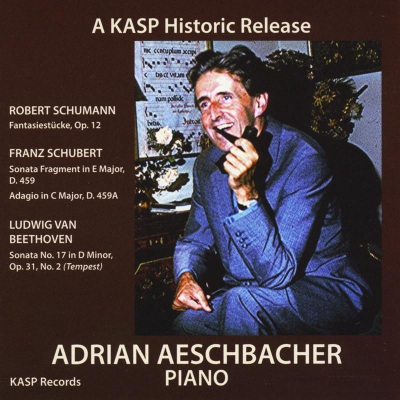
Pianist Adrian Aeschbacher Plays Music of Beethoven, Schubert and Schumann
According to the Classical Music Guide: "Aeschbacher is one of Schumann's great interpreters of all time." And the Audiophile Audition wrote: "In the annals of great Schumann interpretation we recall Geza Anda, Artur Rubinstein, Yves Nat, Robert Casadesus, and Wilhelm Kempff, too often forgetting Adrian Aeschbacher, a pupil of Artur Schnabel whose excellent work with Edwin Fischer and Wilhelm Furtwaengler remains precious to collectors and connoisseurs." Though there was never any doubt in our minds about the great artistry of Swiss pianist Adrian Aeschbacher (1912-2002), or of our desire to present another disc of his playing, we were particularly pleased that our previous release, of his performances of the Romances and Davidsbündlertänze of Schumann, and the Moments Musicaux of Schubert on KASP 57671, received unanimous praise. Originally a student of his father, the choral conductor, Carl Aeschbacher, Adrian Aeschbacher later worked with Emil Frey and Volkmar Andreae at the Zürich Conservatory before moving to Berlin in 1932, where he studied with Artur Schnabel. During his early and middle years he had a very active performing career in Europe and South America. He also made many recordings, particularly of works of Beethoven, Schubert, Schumann and Brahms though, aside from the previous KASP release, few of them are currently available, with the exception of performances of the Beethoven First Concerto and the Brahms Second Concerto with Furtwängler, and the Bach D minor Three Piano Concerto with Edwin Fischer and Paul Baumgartner. It is no exaggeration to describe the performance presented here of Schumann’s Fantasiestücke as one of the finest ever made. Adrian Aeschbacher breathed this composer’s idiom in a way not equaled by many others. If he understood Schumann through and through, Adrian Aeschbacher succeeded no less with the two Schubert works he plays here. The E major Sonata Fragment on this disc moves along beautifully, yet efficiently, with taste and class. The C major Adagio, by contrast, rather like some of the Moments Musicaux, becomes a larger and deeper work than it seems at first glance, and provides some of the most gorgeous and heartfelt moments on this recording. Finally, we come to Beethoven’s Tempest Sonata. Beethoven was also a leading composer in the musical life and career of Adrian Aeschbacher. His teacher, Artur Schnabel, was the first person to record the 32 piano sonatas of the great man from Bonn, and was particularly famous for his insight into this music. Aeschbacher spent a great deal of time working on, and thinking about this music, too. And, in the 1958-59 season, he performed the entire cycle of the 32 sonatas in Zürich, later repeating it in Bern, Basel, Düsseldorf and Amsterdam. As one can hear in this interpretation, by turns gentle, stormy, dramatic but always convincing, Adrian Aeschbacher was deeply imbued with the spirit of this music.
